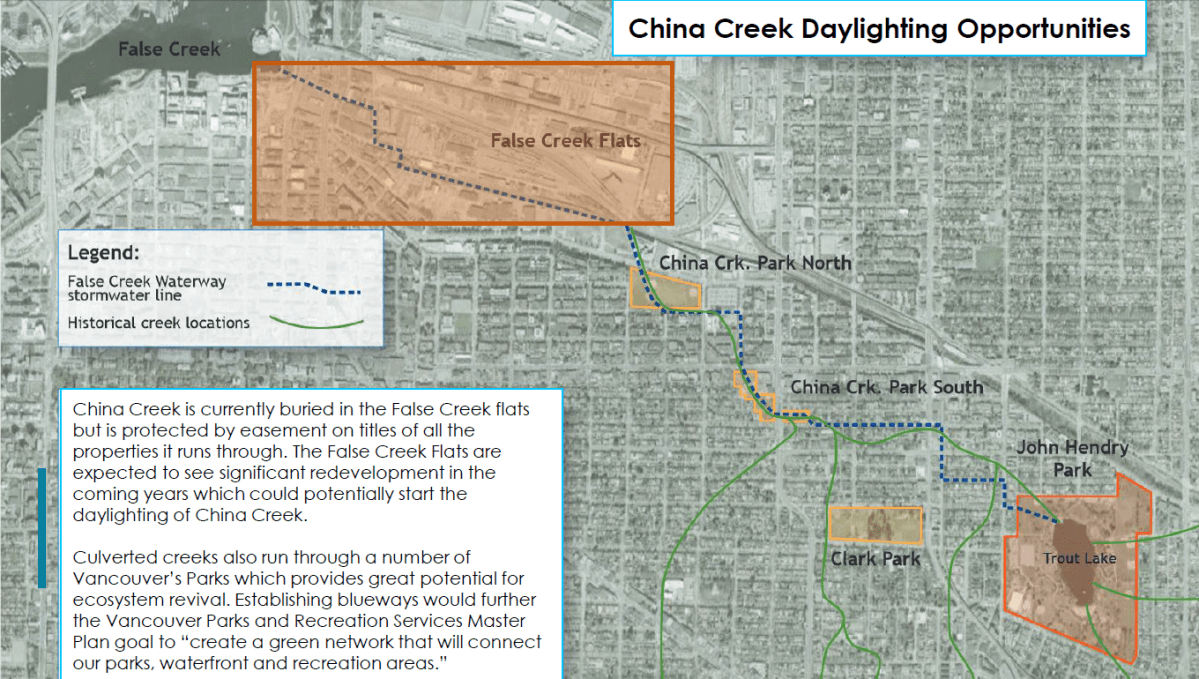Imagine being able to walk, creekside, all the way from False Creek to the confluence of the Brunette and Fraser Rivers in New Westminster.

That’s the ambitious vision being proposed by Vancouver Green Coun. Micheal Wiebe, who earned support for the creation of a regional “blueway” at both Vancouver City Council and the Metro Vancouver Regional Parks Committee on Wednesday.
It’s an enormous proposal that would see the Brunette River, Burnaby Lake, Still Creek and Trout Lake connected and former creeks that have been paved over or culverted, like Vancouver’s China Creek, linked together to create a single, continuous waterway.
The idea could result in Trout Lake being clean and swimmable again, and help the city deal naturally with flooding and wastewater.
Wiebe has no illusions about the scope of the idea, which he admits could take more than 20 years and “tens of millions of dollars.”
WATCH: Salmon returning to Burnaby stream (2015)
“It’s a considerable distance and it’s a big move,” he said.
“We’re talking a sizable, sizable creek network that’s going to go all the way through, but I think once we start doing some big wins people are going to start realizing, ‘Oh wow, this could look amazing.'”
Vancouver council unanimously supported the idea in principle and has asked city staff to come back with reports on scope and feasibility by November.
Wiebe said as massive as the job will be, at Vancouver’s end the work won’t necessarily be as hard as some people imagine.
Much of the land in question is already owned by the city, or in the hands of potential partner companies like Lululemon or Mountain Equipment Co-op, he said.
“A lot of it’s already been mapped out with easements and that’s why we have to recognize that council, 30 years ago, said maybe this will happen. And so they’ve kind of protected a lot of it,” he said.
WATCH: Salmon recolonize urban stream (2013)
Elmer Rudolph, president of the Sapperton Fish and Game Club in New Westminster, called the idea “fantastic.”
The Sapperton club is among groups who have worked for years to clean up the Brunette River, helping transform it from a polluted waterway in the 1960s back into a salmon-bearing stream.
“When you looked at the at the river you could not see the water. All you could see was the junk and the debris and the flotsam and everything else floating on the water,” he said.
“It looked like a rubble field or something.”
Rudolf said when he started, getting people on board with stream restoration was like “pulling teeth.”
But in the decades since, he said there has been a sea change in the way governments and private companies have looked at restoration projects, and that the time might well be right for an idea of this scale.
“In the future, if it works out, in every waterway you’re walking in you might see wildlife,” he said.
“You could walk from the mouth of the Burnette looking at wildlife, walk it through interconnected streams and see wildlife, all the way through to Vancouver. That would be absolutely great.”
Wiebe said to work, the project work will likely need to be spearheaded by Metro Vancouver and will require buy-in from Burnaby and New Westminster, along with First Nations and many other stakeholders, but he said he believes the region can get it done.
“This could go to a way that will have a significant component to our city that we haven’t seen in a long time and hopefully generations from now people won’t believe that it never existed,” he said.






Comments